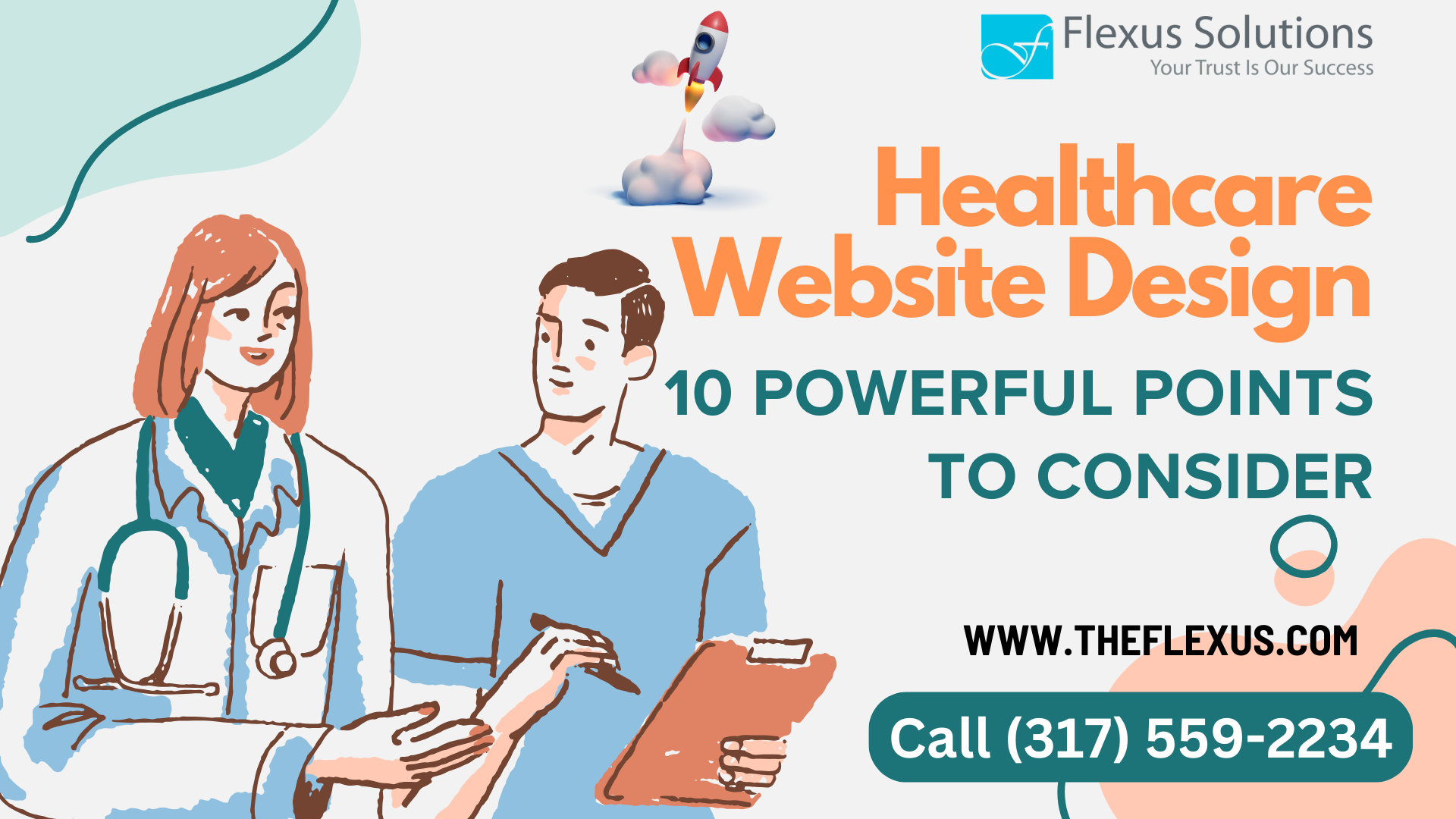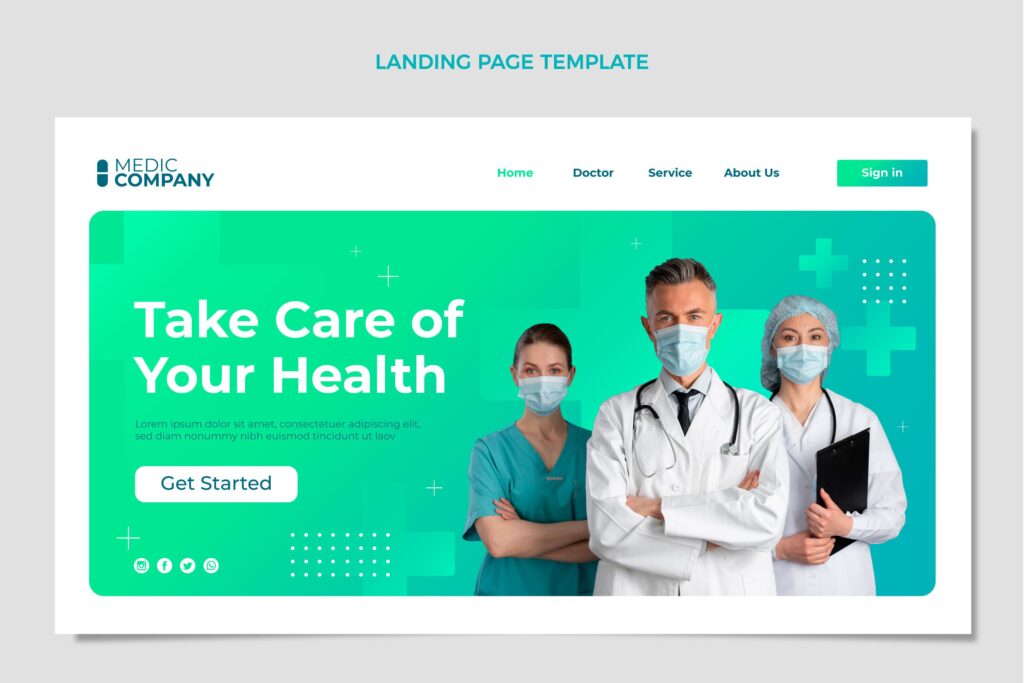
Do you own a healthcare site but find it hard to turn viewers into users? In this digital era, owning a high-performing site is key to your healthcare business’s success. But what exactly sets a healthcare site apart and encourages user conversion?
On this webpage, we’ll examine the top 10 essential aspects that can shift your health-related site into a tremendous catalyst for engagement. Ranging from user-friendly browsing to captivating material, we’ll encompass all necessary details to construct a site that draws in your viewers and spurs them to act.
Picture a website that enlightens your visitors and persuades them to turn into faithful customers. The moment has come to unleash your healthcare website’s potential and raise your conversions. Regardless if you’re a healthcare provider, medical expert, or healthcare business owner, this article is crafted for your needs.
Come along as we explore the realm of successful healthcare websites and learn the key strategies for drawing in, captivating, and turning your intended audience into customers. Let’s begin on building a website that genuinely links with your site visitors and transforms them into forever clients.
Table of Contents
Short Summery
- A well-designed healthcare website is crucial for converting visitors into customers.
- User-friendly navigation and information architecture are essential for enhancing the user experience on your healthcare website.
- Mobile responsiveness and compatibility are important to ensure a seamless experience for users accessing your website on mobile devices.
- Patient engagement tools and features, such as patient portals, can improve patient care and satisfaction.
- Integration of secure patient data management systems is vital for maintaining data security and privacy.
- Educational resources and health information should be incorporated into your website to provide valuable content to your audience.
- Appointment booking and contact information should be easily accessible for patients seeking healthcare services.
- Testimonials and reviews can provide social proof and build trust with potential customers.
- Interactive tools and calculators can enhance user experience and provide additional value to visitors.
- Optimizing your website for search engines is essential for attracting organic traffic and improving your digital marketing campaign.
1. Importance of a Well-Designed Healthcare Website

Nowadays, a high-quality health website is essential for medical workers and service providers. It’s not just an online footprint, but also actively helps with patient involvement, guarding people’s info, and boosting a healthcare business’ success. Let’s delve into why a health website properly designed is incredibly significant within the healthcare field.
1.1 Establish Credibility and Trust
A good healthcare web page is like an online version of a healthcare provider or group. It builds trust and acceptance from visitors, including prospective patients, by displaying proficiency, skill, and dedication to top-notch patient treatment. The site should highlight key data about the medical service, like contact details, services provided, and feedback from pleased patients (Healthcare Website, Patient Review).
1.2 Educate and Inform
A key role of a healthcare website is to give correct and current health facts (Health Info, Educational Material). By sharing trusted information on different health issues, treatment choices, and well-being data, such websites can instruct visitors and enable them to make knowledgeable choices regarding their health. The writing needs to be neat, professional, and captivating, fitting the content’s purpose and audience (Compose in a neat, professional, and captivating manner).
1.3 Improve Patient Care and Engagement
A great health website can boost patient support by offering vitally needed elements and utilities. Think of it like this, a patient site lets people see their health records, plan visits, and safely exchange words with their healthcare person (Patient Site, Data Safekeeping). It’s good for patients, helps run processes smoothly, and builds better talks between the patients and health workers (Patient Involvement, Health Worker).
1.4 Enhance User Experience
A healthcare site’s triumph largely depends on the user experience. It is crucial that the web design is simple to use and navigate (Simple Use Design). This assures that visitors can effortlessly traverse the site, secure the data they want, and in the end, have a pleasing encounter (Pleasing Encounter, Guarantee Readers have a pleasing encounter). Uncomplicated maneuvering, lucid structure, and easy-to-understand features won’t just retain users’ interest but will also inspire future site visits.
A good healthcare website plays a key role in building trust, teaching patients, boosting patient care and involvement, and bettering the entire user experience. It functions as an essential instrument for healthcare experts
2. User-Friendly Navigation and Information Architecture
1. Clear and Intuitive Menu Structure:
Developing a straightforward and understandable menu layout is vital for leading visitors on your site. Arrange your menu elements sensibly, assembling linked pages under suitable categories. Utilize brief and illustrative labels for every single menu element, verifying that visitors can effortlessly comprehend and steer to the preferred sections of your site. As an instance, you could allocate distinct menu elements for services, health issues, client aids, and communication info.
2. Thoughtful Hierarchy and Sub-navigation:
Create a well-structured layout and sub-menu system to improve the user’s experience. Take intricate details and divide them into smaller parts and sub-pages, forming a hierarchy. This lets users search deeper for the precise information they need. It aids them in moving smoothly through your website and discovering pertinent content without feeling swamped.
3. Search Functionality:
Include a search feature on your site to help visitors swiftly locate certain information. Ensure the search box is visibly positioned and reachable from all pages. Plus, enhance your search tool to yield precise and pertinent outcomes based on user inquiries. This will conserve user time and energy, yielding a more satisfying user experience.
4. Consistent and Descriptive Page Titles:
Craft a distinct, clear, and SEO-optimized title for every page to truly represent its content. This assists both viewers and search engines in grasping the topic and goal of each page. Keeping the format and organization of page titles consistent enhances user interaction and boosts the search engine sight of your website.
5. Breadcrumbs:
Put a breadcrumb trail on top of every page. This shows users their journey to their current spot on your website. Breadcrumbs give context and direction, helping users travel back to past pages or areas without losing their spot. This tool bumps up the total user experience, especially for websites that have lots of content and tricky navigation setups.
For a strong healthcare website, simple directions and organized information are crucial. Have a straightforward menu, careful rankings, a search feature, straightforward page names, and breadcrumb features to improve the user experience.
3. Mobile Responsiveness and Compatibility
In this tech-driven era, it’s potent for health portals to focus on mobile adaptability and harmony. As the use of mobiles and tablets is on the rise, both patients and health experts are fetching health data, facilities, and tools on their gadgets. Therefore, it’s chief for health portals to embrace this wave and offer the best user experience, irrespective of screen sizes.
Importance of Mobile Responsiveness:
1. Improved User Interaction: A health-focused website, adaptable for mobile use, means site guests can handle and connect with the materials smoothly, no matter the gadget used. By allowing trouble-free and easy use, healthcare websites boost patient involvement and enjoyment.
2. Inclusive Style: Making sure healthcare websites work well on mobile helps all people, including those with disabilities or problems. That’s why using easy-to-see design pieces, like the right color contrasts and clear texts, matters. This meets the needs of a large mix of users.
3. Better Position on Search Engines: Sites that work well on mobile get a top spot on search engines like Google. A mobile-ready healthcare site can help your efforts in search engine optimization (SEO). It can boost how visible you are and increase natural traffic.
Best Practices for Mobile Responsiveness:
1. Flexible Web Layout (FWL): It’s vital to apply a flexible web layout to your medical website. This guarantees your site shifts its structure and info to match the viewer’s gadget and screen dimensions. It fosters uniformity and easy reading on various platforms.
2. Boosting Speed & Performance: Folks using mobile devices want websites to load fast and move smoothly. Make it happen by shrinking pictures, trimming server asks, and refining the code. This will boost your site’s speed and performance overall.
3. Simple Click Functions: Health web pages should have big buttons and items you can tap on. This helps people using their devices just by touching.
Being able to use a healthcare website on your phone isn’t just a nice to have anymore. It’s a must-have!
4. Patient Engagement Tools and Features
Having a healthcare website that engages patients is super important. By giving patients stuff that makes their experience better, doctors can make a stronger bond with people visiting their site. In this part, we’ll look at some top tools and ways to make your healthcare site great.
1. Patient Portals:
A patient portal is like a safe online toolbox. It lets people see their health records, chat with their doctors, and handle their meetings and medicines. By using a patient portal, you give your patients the steering wheel to their health journey. They can easily peek at their health data, ask for medicine refills, and even send their doctors a message for not-so-urgent questions.
2. Appointment Scheduling and Reminders:
A simple and easy-to-navigate appointment booking system is vital for health-related websites. Include an effortless online booking function that allows patients to schedule appointments with ease. Plus, automatic reminders through email or text can greatly cut down missed appointments and increase overall patient happiness.
3. Educational Resources:
Having many learning tools on your health website is crucial for giving patients understanding and endorsing overall health. Serve complete articles, videos, and visuals that define medical conditions, treatment choices, and health data. The tools must be trustworthy, current, and easy to use, making sure that patients can get the data they need in a simple to understand format.
4. Patient Testimonials and Success Stories:
Include testimonials and success stories from your patients on your healthcare site to inspire trust and show worthiness. Satisfied patients sharing their good experiences and results demonstrate the high-quality healthcare your team delivers. These shared thoughts stand as strong endorsements to potential patients, assuring them of excellent medical service and patient care.
5. Mobile Optimization:
In our current technological era, it’s crucial to optimize your healthcare website for mobile gadgets. Most web users use their smartphones and tablets for online activities, therefore, it’s critical for your site to be mobile-responsive for a smooth user experience. In essence, your site should function perfectly on different screen sizes. This lets patients gather info and interact with your site effortlessly.
Getting patients involved is key for a top-rate healthcare website. Include patient portals, ways to book appointments, learning materials, patient feedback, and make sure it works well on mobiles. This will improve patient interaction and create confidence.
5. Integration of Secure Patient Data Management Systems

In healthcare website development, a key part not to be missed is adding safe patient data systems. This part is central in keeping patient data private, and helps the healthcare services run smoothly. Let’s delve into why this is important and how to put these safe systems into place.
1. Keeping Patient Data Safe: In the medical field, it’s crucial to guard confidential patient details. As online dangers grow, medical establishments should focus on ensuring data safety to keep patient confidence. Solid encryption practices, security walls, and secure socket layers (SSL) are useful in preventing unwanted access to patient data.
2. Following HIPAA Rules: Health-related websites need to follow the Health Insurance Portability and Accountability Act (HIPAA) rules. These are made to keep patient privacy and safety. These rules give instructions for safely dealing with protected health information (PHI). They say how health organizations should deal with, send, and keep patient’s data.
3. Adding a Patient Portal: A patient portal on your site helps to increase patient involvement and smooth out communication. This portal lets people see their medical records, easily set up appointments, safely chat with healthcare pros, and pay bills online. Giving patients simple access to health data helps them feel in control and active in their own care.
4. Checking User Permissions and Limiting Access: For patient data to remain safe, it’s crucial to apply checks on user permissions and limit access. Features like strong login details, use of multiple authenticator systems, and specifying access based on roles can aid in stopping unwanted access to delicate patient details.
5. Simple Merging with Online Health Files: Merging online health files or electronic health record (EHR) systems with health websites is vital. It makes sharing patients’ health information between the website and EHR problem-free. This helps give better and speedier patient attention. It also makes sure data on the website, like when to see a doctor or test output, is correct and current.
Strong systems for managing patient data are key to a dependable healthcare website. The importance lies in keeping data safe, following HIPAA rules, merging patient portals, adding user verification and access management, and integrating smoothly with EHR systems. This allows healthcare groups to create a secure and sturdy online environment for their patients.
6. Incorporation of Educational Resources and Health Information

Building a strong healthcare website means including learning materials and precise health facts. These bolster your trustworthiness and expertise, while also offering invaluable resources for those visiting your site. Let’s explore the essential elements of adding such educational materials and health data to your healthcare website:
1. Give Trustworthy Details: Check that your health facts and learning materials are correct, current, and backed by trustworthy sources. This develops faith in your viewers – patients, health experts, and those seeking medical information.
2. Use Different Types of Content: Use assorted materials like articles, blog entries, videos, infographics, and engaging tools. This feeds into varied learning styles and boosts visitor interaction. For example, make clear videos about medical conditions or make fun quizzes to instruct visitors on assorted health subjects.
3. Design Straightforward Navigation: Put in place an easy-to-use and straightforward navigation scheme that helps visitors efficiently discover and access necessary data. Group health resources by medical fields, types of health issues, possible treatments, or health wellness data. This method aids individuals in promptly and effectively obtaining precise details they’re seeking.
4. Showcase Patient Stories and Examples: Use real-life examples and patient stories that talk about successful results or good experiences with your health services. These true stories add trustworthiness and make future patients feel surer in picking your healthcare provider.
5. Prioritize smartphone and tablet compatibility: A surge in the use of handheld gadgets makes it essential for your learning materials and wellness facts to be easily reached on mobile tech. Put into action a versatile layout that accommodates various display dimensions, promising an unbroken user encounter on all gadgets.
6. Team Up with Health Experts: Work alongside doctors, experts, or trusted medical institutions to enrich your learning material. This teamwork boosts your site’s standing and gifts your audience with professional viewpoints and knowledge.
7. Keep Up with Industry Norms: Always be in the loop with the freshest insights, progress, and top methods in healthcare. Routinely refresh your learning tools and health facts to mirror the latest medical wisdom and care choices. This shows your dedication in giving correct and timely information to your audience.
💡 Key Point: Putting trustworthy, educational content on your healthcare web page builds credibility and strengthens trust, leading to a better user experience. You can achieve this by including dependable information, offering various presentation styles, intuitive direction, patient stories, mobile-friendly designs, expert partnerships, and keeping current.
7. Integration of Appointment Booking and Contact Information
A key feature of an effective healthcare site is smooth linking of appointment scheduling and contact details. Giving straightforward access to these elements boosts the user’s journey and simplifies patients’ ability to book visits or connect with your healthcare office.
1. Appointment Booking System:
Adding a straightforward, effective appointment scheduling system to your site can greatly boost patient happiness and multiply booking rates. Think about merging powerful booking software that lets patients pencil in appointments on the internet, removing any reason to make phone calls or endure hold time. This not only saves time for both patients and the office team but also lessens the chance of forgotten appointments or messed up schedules.
2. Easy-to-Find Contact Information:
It’s key to display your contact info visibly and simply on your website. Have a specific “Contact Us” section. Put necessary details like phone number, email, and physical address there. Also, think about showing this info at the top or bottom of every page. This helps users find it, no matter where they are on your site.
3. Click-to-Call Functionality:
In our modern era, many folks could be visiting your website via their phones. By adding a click-to-call feature, you streamline the process for users to get in touch with your healthcare service in just one click. This handy tool lets guests start a call straight from your site, getting rid of the task to punch in the digits manually.
4. Appointment Reminders and Confirmations:
Think about setting up a machine-controlled system for dispatching reminders and confirmations of appointments. You could do this through email or text messages. This guarantees patients remember their visits, and decreases the quantity of missed slots. Giving patients regular updates boosts their experience and makes your practice run smoother.
5. Testimonials and Reviews:
Showcase appreciative feedback from happy patients who liked your healthcare. It creates faith, proving to possible new patients that your healthcare is top-notch. Putting these praises near the contact info could play a strong role in getting additional patients and boosting results.
Merging appointment scheduling and contact details is vital for healthcare websites. Introducing a simple appointment booking process, visible contact data, ‘click-to-call’ feature, reminders, and reviews can boost patient interaction and elevate satisfaction levels overall.
8. Testimonials and Reviews for Social Proof

Healthcare website design hinges on testimonials and reviews. These tell the story of your services, affirming that you’re trustable and credible. Showcasing praises from patients and experts paints a picture of high standard services. Add reviews and testimonials on your website. This will beef up your online state and draw in potential patients.
1. The Power of Testimonials
Reviews are direct stories from happy patients or health professionals who have tried your services themselves. They show the great effect your medical practice brought to their lives. Adding reviews to your site helps possible patients understand the standard of care they can look forward to and helps build belief in your skills.
2. How to Gather Testimonials
Touch base with your patients or healthcare coworkers and request their opinions and endorsements. You could give them a survey or ask them face-to-face to collect their feedback. Make sure their endorsements are truthful, detailed, and highlight the distinct parts of your services. Don’t forget to get approval from the people before placing their endorsements on your online site.
3. Displaying Testimonials
Creating a webpage for testimonials on your site may be useful. Make it stand out on your main page. Display each one with the person’s name, their job, and a picture, if you can. This makes it seem more real. Try making a section where testimonials rotate. This way, different stories can be shown. It can keep users on your site more engaged and interested.
4. Leveraging Online Reviews
In addition to people’s feedbacks, web ratings from sites like Google My Business, Yelp, or specific health care rating websites can give extra social evidence. Urge your patients to write reviews, and keep an eye on and answer them often. Positive web ratings will not only enhance your online image but will also boost your position on search engine listings.
5. The Impact of Social Proof
Feedback and ratings show how good the healthcare you give is. They are strong ways to sway possible patients’ choices and show your skills in the healthcare field. By showing good experiences, you show that your practice is a trusted and respected place for health services.
In healthcare, the value of comments and evaluations is enormous. They help to build faith and reliability. Including this social proof on your site can pull in possible patients. It shows how good your medical services are. This makes you a healthcare provider that people can trust.
9. Integration of Interactive Tools and Calculators

In the always changing world of health website designs, one important part shines: using interactive tools and calculators. These amazing features don’t only improve how the site feels to visitors, but they also give helpful resources. This lets site visitors make smart choices about their health and any health problems.
1. Personalized Health Assessments:
Using handy tools like health checks, health websites can give users customized advice and direction. This advice is based on their unique health situations and objectives. These checks help users find possible risks, evaluate their total health, and suggest ways to prevent problems or fit treatment choices.
2. Symptom Checkers:
Health survey tools are useful aids that allow individuals to assess their health issues and gain a deeper comprehension of potential sources or ailments. With a set of pointed questions, these aids offer users initial opinions and suggestions, stressing the need to see a medical expert for a correct diagnosis and remedy.
3. Treatment Cost Calculators:
Sorting out money matters in healthcare often puzzles many. But, by adding cost calculators in healthcare sites, patients can guess the costs for certain processes or services. It’s vital to have design that’s easy to navigate and user-friendly interfaces. This way, patients can get cost estimate easily and decide wisely on their healthcare choices.
4. BMI Calculators:
BMI (Body Mass Index) tools are popular for encouraging good health and checking risks connected to weight. These engaging apps let people calculate their BMI using their height and weight. They offer clues to possible health issues and propose relevant health advice or plans for treatment.
5. Medication Reminders:
People dealing with many prescription drugs or complicated drug plans can find medication reminder tools very useful. These tools can keep patients in line by giving reminders when it’s time for their medicine, making sure they’re sticking to the plan and lessening the chance of forgotten doses.
Healthcare websites now incorporate helpful tools like health assessment calculators. Such tools enable symptom checks, cost forecasts for treatments, and Body Mass Index (BMI) measurements. Handy features like medication reminders are also included. These applications foster patient involvement, promote informed choices, and make healthcare more patient-friendly overall.
10. Optimization for Search Engines

Crafting a potent site for the health sector demands that it be optimized for search engines. This process makes sure your site is seen by the right people, boosts your digital footprint, and draws natural traffic to your page. Below are some key tactics for improving your health website for search engine visibility:
1. Do Keyword Investigation: Begin by finding suitable keywords your audience would likely use in searches. Note that these keywords should connect to medical aids, health issues, treatment options, and distinct healthcare subjects. Carefully weave these keywords into your website’s content, spanning headers, main text, and meta tags.
2. Page-Focused SEO: Apply page-focused SEO tactics to simplify search engine processes for recognizing and placing your website. This involves enhancing your page titles, description metadata, and web addresses with pertinent key terms. Utilize precise subheadings (H3) as well as labels (H4) for structuring your content, facilitating search engine crawling.
3. Top-Notch Content: Strive to craft easy-to-understand and captivating content that benefits those visiting your site. It means choosing straightforward and neat language, adding important numbers and facts backed by data, and tackling common healthcare queries.
4. Site Usability: Make your website easy to use with smooth browsing. Boost your site’s loading speed, navigation setup, and adjust it for mobile to elevate user experience. Happy users on your website boost your image and increase the odds of them coming back for more info.
5. Mobile Adaptation: As more people use mobile devices, adjusting your healthcare site for mobile users is key. Ensure your website is flexible and adjusts to different display sizes for the best view. This will boost user involvement and search engine spot.
6. Area-based SEO: Say you’re a health service aiming at a particular area, tune your website for local searches. This consists of listing your touch-points like your location, contact number (317) 559-2234, and days and timings of operation in plain sight on your site. Enlist your venture on Google My Business and various internet directories to boost local exposure.
7. Safe Site: Keeping data safe is very important in the health field. Make your site safe! Put in an SSL certificate, code patient data, and update your software often. This keeps patient info safe. Plus, it shows you value privacy, which builds trust with your audience.
Conclusion
To wrap up, a potent health industry website is key for your digital footprint and drawing possible clients. By using this roadmap, your website can appear polished while still giving useful details and features to the people you aim to serve. First, know who your audience is and their wishes. Then, shape your website to match this, making sure it’s easy to get around and pleasant to use.
Add the right, top-notch content that displays your skill and makes you a reliable source in the health sector. Boost your site’s performance by gearing it to search engines, speeding up loading, and preparing it for mobile use. Always remember to include powerful urging actions on your site, prompting visitors to reach out or ask for additional info.
How do I make my website interactive?
To make your website engaging, consider incorporating elements like chatbots, comments section, surveys, and other interactive bits.
What is the importance of a healthcare website?
A strong healthcare site can draw in patients and boost your earnings. Patients need to feel you’re a reliable info source, and a good website can get you there.
How do I select the right website design for my business?
Before picking a design, let’s pose a few queries. Who do you aim to reach? What do you wish to accomplish with your business? What budget limits do you have? After responding, narrow your choices will be simpler.
What are the different types of healthcare websites?
Websites about healthcare come in two main varieties: those centered on medical matters, and ones focused on health and wellness. The former, “medical” websites, bring information and services tightly linked to healthcare. On the other hand, “health” websites lean into the broader themes of well-being and healthiness.
How do I make my website mobile-friendly?
A top method to guarantee your site works well on mobile is to code with HTML5 and CSS3. Also, your site should adapt to different devices, like smartphones, tablets, and laptops, with responsive design. This ensures a great visual on various gadgets.
How do I make my website compatible with mobile devices?
A couple of steps can ensure your website works well on mobile devices. Make your site responsive to appear pleasing on any device, or include specific features for mobile-friendly use. Include elements that simplify navigation on mobile platforms.


